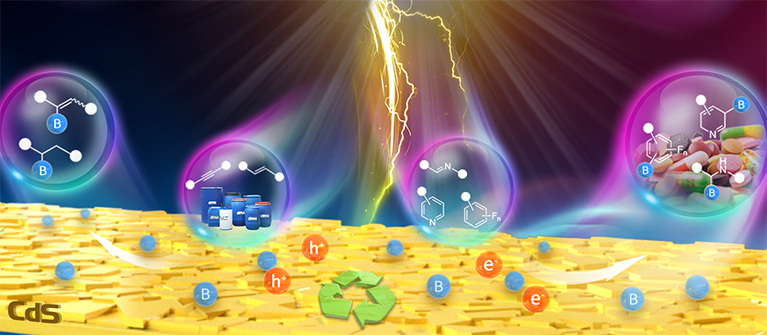Due to its stable chemical properties and simple preparation method, nitrogen heterocyclic carbene
borane (NHCBH3) has been used as a new type of boron source in free radical boronation reactions
in recent years. However, the use of a large number of harmful free radical initiators or expensive
and unrecoverable homogeneous photocatalysts still hinders their widespread application. Therefore,
developing a universal, inexpensive, and recyclable catalytic system is of great significance for the
development of free radical boronation reactions involving NHC-BH3.
Recently, Dai Wen's team, a researcher at the Dalian Institute of Chemical Physics, Chinese Academy
of Sciences, made new progress in multiphase photocatalytic boration. The team selected easily
prepared cadmium sulfide nanosheets as multiphase photocatalysts and utilized the synergistic
redox effect of photo generated electrons and holes to achieve high-value conversion of olefins, alkynes, imines, and aromatic (hetero) rings through selective boronation
reactions, synthesizing borohydride and boron substituted products. The relevant achievements were
published in the German Journal of Applied Chemistry and were selected as a hot topic article.

Schematic diagram of semiconductor photocatalytic boronization reaction.
The Devon team has developed a simple and efficient multiphase photocatalytic system. This system
utilizes easily prepared cadmium sulfide nanosheets as multiphase photocatalysts, NHCBH3 as a boron
source, and achieves selective boronation reactions of various olefins, alkynes, imines, aromatic (hetero)
rings, and bioactive molecules under room temperature illumination. Due to the full utilization of photo
generated electron hole pairs in this conversion process, the use of sacrificial agents is avoided. Further
research has found that this catalytic system can not only achieve gram scale amplification, but also
maintain stable yield after multiple cycles of the catalyst. At the same time, as a recyclable universal
platform, the recovered catalyst can still continue to catalyze boronation reactions of different types
of substrates. These results can provide new ideas for the development of free radical boronation
reactions using NHC-BH3 as the boron source.
In addition, the obtained organic borides were derivatized and synthesized into synthetic blocks
containing hydroxyl groups, borate esters, and difluoroborane reaction active sites.
Technological innovation
Honesty is the foundation
Contact Number: +86-15698999555 |
Address: NO.6 ,SHENGHUA STREET,TAIHE DISTRICT, JINZHOU CITY, LIAONING PROVINCE, CHINA. |